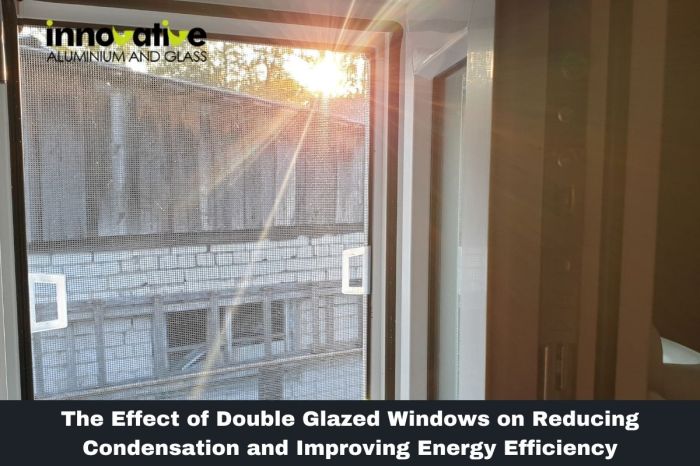How Double-Glazing Windows Affect Energy Bills
How Double-Glazing Windows Affect Energy Bills sets the stage for this enthralling narrative, offering readers a glimpse into a story that is rich in detail and brimming with originality from the outset.
Double-glazing windows are a game-changer when it comes to energy efficiency in homes. They not only reduce heat loss and noise but also have a significant impact on energy bills. Let's dive deeper into how these windows work wonders for your wallet and the environment.
Introduction to Double-Glazing Windows

Double-glazing windows are windows made with two panes of glass separated by a gap filled with either air or gas. This design helps improve energy efficiency by reducing heat loss and minimizing noise from the outside environment.
Benefits of Double-Glazing Windows
- Reduced Heat Loss: Double-glazing windows provide better insulation, helping to keep the indoor temperature stable and reducing the need for constant heating or cooling. This can lead to significant savings on energy bills.
- Noise Reduction: The two layers of glass in double-glazing windows act as a barrier to outside noise, creating a quieter and more peaceful indoor environment.
Types of Materials Used in Double-Glazing Windows
Various materials can be used in the construction of double-glazing windows, each with its own impact on energy bills:
- uPVC Frames: uPVC frames are a popular choice for double-glazing windows due to their durability, low maintenance, and thermal efficiency. They help in reducing heat loss and improving overall energy efficiency.
- Aluminum Frames: While aluminum frames are lightweight and strong, they are less energy-efficient compared to uPVC frames. They conduct heat more easily, which can lead to higher energy bills.
- Wooden Frames: Wooden frames provide a classic look and excellent insulation properties. They can help in reducing energy bills by maintaining a comfortable indoor temperature.
Energy Efficiency of Double-Glazing Windows
Double-glazing windows play a crucial role in enhancing energy efficiency within a property. By creating a barrier between the indoor and outdoor environment, these windows help regulate the indoor temperature, resulting in reduced energy consumption for heating or cooling purposes.
Regulating Indoor Temperature
Double-glazing windows are designed with two layers of glass separated by a layer of air or gas. This construction acts as insulation, preventing heat transfer between the interior and exterior of a building. As a result, the indoor temperature remains more stable, reducing the need for constant heating in cold weather or cooling in hot weather.
Barrier Against External Elements
The multiple layers of glass in double-glazing windows create a barrier against external elements such as wind, rain, and noise. This barrier not only enhances the comfort level within a property but also contributes to energy savings by minimizing the impact of external conditions on the indoor temperature.
Cost-Effectiveness Compared to Single-Pane Windows
In terms of cost-effectiveness, double-glazing windows outperform single-pane windows by providing better insulation and reducing energy consumption. While the initial cost of installing double-glazing windows may be higher, the long-term savings on energy bills make them a more economical choice in the context of energy efficiency.
Factors Influencing Energy Savings
Climate, orientation of the house, and local weather conditions play a crucial role in determining the energy-saving potential of double-glazing windows. Proper installation and maintenance are also key factors that can influence the overall energy efficiency of these windows. Additionally, the design, thickness, and coatings of double-glazing windows can significantly impact their ability to save energy.
External Factors Impacting Energy Savings
- The climate in which a house is located can greatly affect the energy savings provided by double-glazing windows. In colder climates, these windows help retain heat indoors, reducing the need for heating. Conversely, in warmer climates, they can prevent heat from entering, reducing the reliance on air conditioning.
- The orientation of the house also plays a role. South-facing windows receive more sunlight throughout the day, which can be beneficial in colder climates but may lead to excessive heat gain in warmer regions.
- Local weather conditions, such as wind patterns and average temperatures, can impact the effectiveness of double-glazing windows. Understanding these factors can help homeowners optimize the energy efficiency of their windows.
Importance of Installation and Maintenance
- Proper installation of double-glazing windows is essential to ensure airtightness and prevent heat loss or gain. Any gaps or leaks can compromise their energy-saving capabilities.
- Regular maintenance, including cleaning and inspecting for damage, is crucial for preserving the efficiency of these windows over time. Neglecting maintenance can lead to decreased performance and higher energy bills.
Role of Window Design, Thickness, and Coatings
- The design of double-glazing windows, including the number of panes and the spacing between them, can impact their insulation properties. Optimal design choices can enhance energy efficiency and reduce heat transfer.
- Thicker glass panes provide better insulation and soundproofing, contributing to improved energy savings. Additionally, low-emissivity coatings can further enhance the thermal performance of double-glazing windows.
- Choosing the right combination of design elements, thickness, and coatings can maximize the energy-saving potential of double-glazing windows, making them a valuable investment for homeowners looking to reduce their energy bills.
Cost Considerations and Return on Investment

Installing double-glazing windows involves an initial cost that may seem high to some homeowners. However, it's essential to consider the long-term benefits in terms of energy savings and the return on investment that these windows can provide over time.
Comparison of Initial Cost and Long-Term Energy Savings
While the initial cost of installing double-glazing windows can vary depending on factors such as the size of the property and the type of windows chosen, it is important to compare this cost to the potential energy savings in the long run.
Double-glazing windows are designed to improve energy efficiency by reducing heat loss, which can lead to significant savings on heating and cooling bills over time.
Potential Return on Investment
Homeowners can expect a substantial return on investment from reduced energy bills over the lifespan of double-glazing windows. By decreasing the amount of energy needed to heat or cool a home, these windows can help lower monthly utility costs significantly.
The payback period for investing in double-glazing windows can vary depending on factors such as energy prices and climate conditions.
Calculating Payback Period
To calculate the payback period for investing in double-glazing windows based on energy savings, homeowners can use a simple formula. By dividing the total cost of installation by the annual energy savings achieved with double-glazing windows, homeowners can determine how many years it will take to recoup the initial investment.
This calculation can help homeowners make an informed decision about whether investing in double-glazing windows is a cost-effective choice for their property.
Final Wrap-Up
In conclusion, the impact of double-glazing windows on energy bills is undeniable. From reducing heat loss to creating a barrier against external elements, these windows offer a cost-effective solution for homeowners. By investing in double-glazing windows, you're not just saving money but also contributing to a greener future.
FAQs
Do double-glazing windows really make a difference in energy bills?
Yes, double-glazing windows help regulate indoor temperature, reducing the need for excessive heating or cooling and ultimately leading to lower energy bills.
Are there specific factors that can impact energy savings with double-glazing windows?
External factors like climate, house orientation, and local weather conditions play a crucial role in determining the energy-saving potential of double-glazing windows.
What is the average payback period for investing in double-glazing windows?
The payback period for double-glazing windows varies based on factors like energy savings, initial installation costs, and local utility rates. On average, most homeowners see a return on investment within a few years.